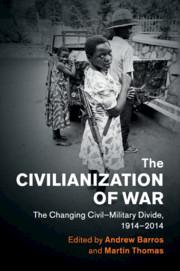Book contents
- The Civilianization of War
- Human Rights in History
- The Civilianization of War
- Copyright page
- Contents
- Tables
- Contributors
- Acknowledgements
- Introduction: The Civilianization of War and the Changing Civil–Military Divide, 1914–2014
- Part I Who Fights? Combatants, Mobilization and the Changing Nature of War
- Part II A Moving Target: Strategic Bombing and Civilians, 1916–2014
- 8 The Problems of Opening Pandora’s Box: Strategic Bombing and the Civil–Military Divide, 1916–1939
- 9 Bombing Civilians Scientifically: Operational Research in Bomber Command, 1941–1945*
- 10 Creating a Cordon Sanitaire: US Strategic Bombing and Civilian Victimization in the Korean War
- 11 The CIA’s Drone War and the Civilianization of Warfare
- Part III Civilian Protection and International Norms and Organizations: When and How Much?
- Index
10 - Creating a Cordon Sanitaire: US Strategic Bombing and Civilian Victimization in the Korean War
from Part II - A Moving Target: Strategic Bombing and Civilians, 1916–2014
Published online by Cambridge University Press: 20 July 2018
- The Civilianization of War
- Human Rights in History
- The Civilianization of War
- Copyright page
- Contents
- Tables
- Contributors
- Acknowledgements
- Introduction: The Civilianization of War and the Changing Civil–Military Divide, 1914–2014
- Part I Who Fights? Combatants, Mobilization and the Changing Nature of War
- Part II A Moving Target: Strategic Bombing and Civilians, 1916–2014
- 8 The Problems of Opening Pandora’s Box: Strategic Bombing and the Civil–Military Divide, 1916–1939
- 9 Bombing Civilians Scientifically: Operational Research in Bomber Command, 1941–1945*
- 10 Creating a Cordon Sanitaire: US Strategic Bombing and Civilian Victimization in the Korean War
- 11 The CIA’s Drone War and the Civilianization of Warfare
- Part III Civilian Protection and International Norms and Organizations: When and How Much?
- Index
Summary
- Type
- Chapter
- Information
- The Civilianization of WarThe Changing Civil–Military Divide, 1914–2014, pp. 196 - 220Publisher: Cambridge University PressPrint publication year: 2018

